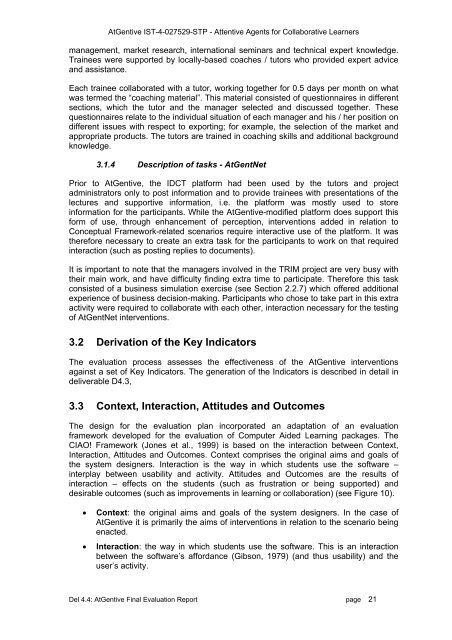Deliverable 4.4 - INSEAD CALT
Deliverable 4.4 - INSEAD CALT
Deliverable 4.4 - INSEAD CALT
Create successful ePaper yourself
Turn your PDF publications into a flip-book with our unique Google optimized e-Paper software.
AtGentive IST-4-027529-STP - Attentive Agents for Collaborative Learnersmanagement, market research, international seminars and technical expert knowledge.Trainees were supported by locally-based coaches / tutors who provided expert adviceand assistance.Each trainee collaborated with a tutor, working together for 0.5 days per month on whatwas termed the “coaching material”. This material consisted of questionnaires in differentsections, which the tutor and the manager selected and discussed together. Thesequestionnaires relate to the individual situation of each manager and his / her position ondifferent issues with respect to exporting; for example, the selection of the market andappropriate products. The tutors are trained in coaching skills and additional backgroundknowledge.3.1.4 Description of tasks - AtGentNetPrior to AtGentive, the IDCT platform had been used by the tutors and projectadministrators only to post information and to provide trainees with presentations of thelectures and supportive information, i.e. the platform was mostly used to storeinformation for the participants. While the AtGentive-modified platform does support thisform of use, through enhancement of perception, interventions added in relation toConceptual Framework-related scenarios require interactive use of the platform. It wastherefore necessary to create an extra task for the participants to work on that requiredinteraction (such as posting replies to documents).It is important to note that the managers involved in the TRIM project are very busy withtheir main work, and have difficulty finding extra time to participate. Therefore this taskconsisted of a business simulation exercise (see Section 2.2.7) which offered additionalexperience of business decision-making. Participants who chose to take part in this extraactivity were required to collaborate with each other, interaction necessary for the testingof AtGentNet interventions.3.2 Derivation of the Key IndicatorsThe evaluation process assesses the effectiveness of the AtGentive interventionsagainst a set of Key Indicators. The generation of the Indicators is described in detail indeliverable D4.3,3.3 Context, Interaction, Attitudes and OutcomesThe design for the evaluation plan incorporated an adaptation of an evaluationframework developed for the evaluation of Computer Aided Learning packages. TheCIAO! Framework (Jones et al., 1999) is based on the interaction between Context,Interaction, Attitudes and Outcomes. Context comprises the original aims and goals ofthe system designers. Interaction is the way in which students use the software –interplay between usability and activity. Attitudes and Outcomes are the results ofinteraction – effects on the students (such as frustration or being supported) anddesirable outcomes (such as improvements in learning or collaboration) (see Figure 10).• Context: the original aims and goals of the system designers. In the case ofAtGentive it is primarily the aims of interventions in relation to the scenario beingenacted.• Interaction: the way in which students use the software. This is an interactionbetween the software’s affordance (Gibson, 1979) (and thus usability) and theuser’s activity.Del <strong>4.4</strong>: AtGentive Final Evaluation Report page 21
















